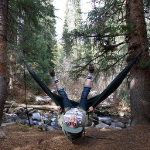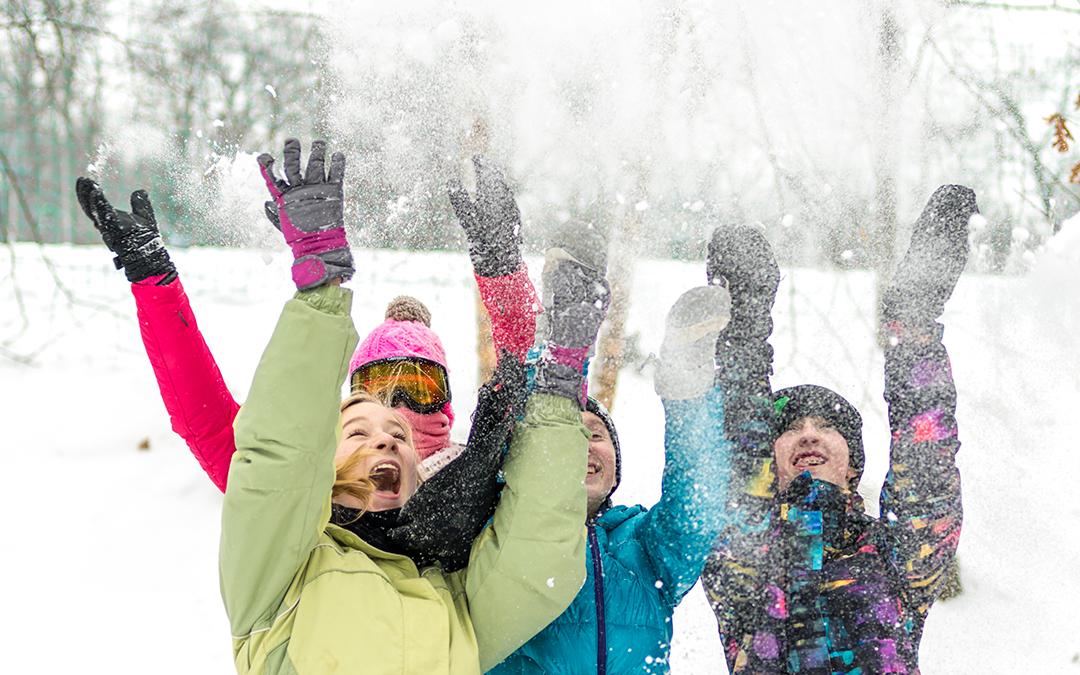For some, winter camping may mean watching frost form on the window from the inside of a cozy, heated hotel room. For others, it may mean packing-in supplies to camp in the snow. Despite how you and your troop plan to get outside this winter, there are some things you should know and plan for when it comes to winter camping.
What’s the Draw?
With exposure to technology becoming ubiquitous, it’s more and more important to help girls get outdoors, no matter the weather or season. A study done by GSUSA found that monthly outdoor exposure contributes to girls’ challenge-seeking and problem-solving abilities. Winter camping has unique problem-solving opportunities not found in the summer months, empowering girls to face those challenges head-on. Honing their camping skills in diverse environments is a sure-fire way to help them feel competent and confident in the outdoors.
What to Pack/Gear
Before any type of camping, it’s important to familiarize yourself and the troop with the ten essentials, a curated list of functional systems. Of course, personal health and safety items are not only limited to items on the list, but this list is a great starting point! Now, let’s get packing.
The Ten Essentials laid out by the National Parks Service are:
- Navigation
- Sun Protection
- Insulation
- Illumination
- First-Aid
- Fire
- Repair Kit/Tools
- Nutrition
- Hydration
- Shelter
The ten essentials guide campers in the planning process of a winter camping experience. Have a discussion with your troop around the relevance of each item. A simple game or pairing of girls into small groups to discuss the importance of essential items may lead to a rich discussion about what may be wanted vs. needed when camping.
Fuel Your Body
One of the most important ways you and your troop can prepare for a winter trip is appropriately fueling your bodies. This means hydrating before the camping trip, especially if anticipating a change in altitude.
In cold weather, it may seem like a burden to stop and make a point of drinking water. One way troop leaders can help facilitate this is leading by example! Make frequent stops while hiking or have planned water breaks throughout the day. Good practice has adults consuming one liter of water per hour they are hiking, and one to two cups of water every hour for children. For trips in the snow or frigid temperatures, heat water over a camp stove to fill girls’ water bottles. This will not only be more appealing than cold water for girls to drink throughout their day, but it also provides them with something warm to hold onto.
Our bodies need double our normal caloric intake while winter camping. It’s important during the planning stages that food is packed to adequately fuel bodies. Eat foods high in carbohydrates, fats, and proteins to keep the body warm and nourished for those long and chilly days. Try to eat lunch while moving. Once seated for lunch, it can often be difficult to get moving again. Stopping gives the body a chance to get cold and muscles to tense up.
But What Do I Wear?!
Staying dry is the key to any positive winter camping experience. When camping in cold weather, it is important to layer clothing. Be sure clothing is lightweight and made of a quick-dry material. Leave your comfortable cotton sweaters at home! Start with a wool base layer, then a mid-weight fleece. An insulation layer, such as a down jacket, should follow. Outer layer, or ‘hard shell layer’ should be your weather resistant layer. This can be something such as a waterproof rain jacket. Remember that a Girl Scout is always prepared. It is better to pack too many layers than to realize there is not enough.
Inevitably, as your troop is hiking, they may sweat, get rained on, or decide making snow angels is a better use of their time. Be sure to change out of wet clothes immediately and hang to dry. Discourage girls from sitting in wet clothing around the fire to dry themselves off.
Nothing Says Uncomfortable like Wet Socks!
For a short period, I was living in the frigid Rockies at 11,000 feet. In my time there, I had a handful of “ah-ha!” moments. Some of which included:
- When shoveling out your car, always turn your water upside down and bury it in the snow so it does not freeze. The snow surrounding the bottle will insulate it (similar to someone in an igloo) and temperatures will not drop below 32 degrees Fahrenheit.
- Sasquatch and Sasquatch culture is very real. If this point is debated, prepare for an argument.
- There is nothing more satisfying than dry socks.
There was not a time where #3 on my list was more relevant than when I was trying to go to bed. When reviewing the ten essentials and preparing for your troop’s winter camping trip, stress the importance of packing plenty of socks.
Nighttime away from home already has its challenges—adding in cold weather is even more challenging. Campers should always change their socks as a part of their nightly routine before they go to bed. Although socks may not feel wet, sweat forms from feet being in boots or shoes all day. When sweat is absorbed by the socks, it may cause feet to feel cold and wet. Feet may also get sweaty when the doubling of socks occurs. Of course, it may seem warmer to put on two pairs of socks as opposed to one. Fool-proof logic, right? Unfortunately not. Wearing multiple pairs of socks trap moisture in, without allowing feet to breathe.
Not only do warm water bottles come in handy while hiking, but also for sleeping! A natural way to heat sleeping bags is by boiling water over a camp stove. Again, fill girls’ water bottles. Instruct them to put them in their sleeping bags. This will work to heat up their bags before they go to bed. This is a warm item they can hold onto as they are drifting to sleep. Just be sure those caps are screwed on tightly!
A Girl Scout is always prepared. And with some planning, winter camping has the potential to be a great adventure for you and your troop. And after the preparation, it should be snow big deal! Happy wintry trails!
What to do next:
- Winter camping can be affordable and accessible for everyone. Search your local thrift stores for winter camping appropriate outfits and gear. If you’re a Basementeer, you can get 10% off your purchase at Sports Basement, and Girl Scouts of Northern California will receive a donation. It’s a win-win.
- Not sure where to go? If you’re in the Bay Area, 7×7 has a list of great winter camping spots.
- After your awesome winter camping trip, tell us all about it! Share your pictures and favorite memories on our Facebook, Instagram, or Twitter or in the comments below.
 Arri DeJesus—Arri is the STEM Program Specialist for Girl Scouts of Northern California, where she supports the development, implementation, and evaluation of innovative STEM related program opportunities and materials. Prior to working at the NorCal council, she worked at camp through Girl Scouts San Diego. When she is not working out of the Alameda office, she enjoys being outdoors camping, hiking, and taking photos.
Arri DeJesus—Arri is the STEM Program Specialist for Girl Scouts of Northern California, where she supports the development, implementation, and evaluation of innovative STEM related program opportunities and materials. Prior to working at the NorCal council, she worked at camp through Girl Scouts San Diego. When she is not working out of the Alameda office, she enjoys being outdoors camping, hiking, and taking photos.



Hey Girl Scout Campers,
Be sure to check out the Camping Safety Activity Checkpoint (https://www.gsnorcal.org/content/dam/girlscouts- found gsnorcal/documents/volunteer_resources/sac/camping.pdf) for more information on how to plan your camping trip.
And don’t forget to submit your Trip or High-Adventure form to our Risk Management team (https://www.gsnorcal.org/en/our-council/documents-and-publications/Trip_Or_High_Adventure_Approval_Form.html) 7-10 business days before your trip.
Happy Camping!
Important reminders! Thanks Mary!